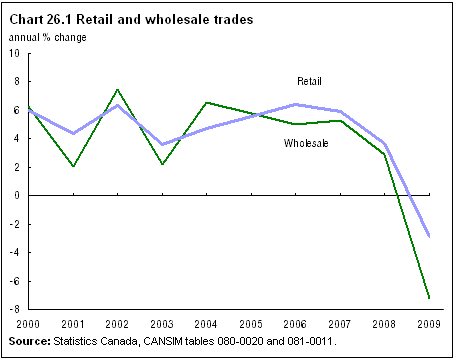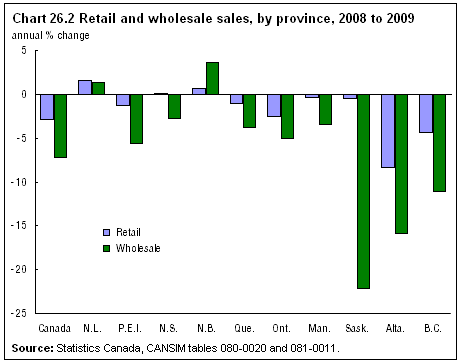Retail and wholesale trade
Archived Content
Information identified as archived is provided for reference, research or recordkeeping purposes. It is not subject to the Government of Canada Web Standards and has not been altered or updated since it was archived. Please "contact us" to request a format other than those available.
Related information
Both retailers and wholesalers saw a drop in their trade totals in 2009 for the first time in almost 20 years, resulting from the steep economic decline of 2008.
Retailers experienced a 2.9% decline from 2008, with their sales totalling $415 billion in 2009. This drop follows a 3.7% increase in 2008, following increases of 5.9% in 2007 and 6.4% in 2006. Wholesalers experienced a loss of 7.2%, with their sales totalling $495 billion. This compares with increases of 2.9% in 2008 and 5.3% in 2007.
Although retail and wholesale sales rose throughout most of 2009, businesses were still recovering from much slower sales at the end of 2008 and were unable to regain all the lost ground.
Gas sales drop sharply
A major contributor to lower retail sales was a 21.4% drop in sales of automotive fuels in 2009, a reflection of falling gasoline prices.
A 10.2% decrease in the value of the sales of new vehicles (cars and trucks) pulled down retail sales overall. Automotive retailers had a hard time selling vehicles, with a 17.9% decline in the value of sales of new cars. Retail sales of used vehicles were down 3.9%, while retail sales of recreational vehicles were down 9.4%.
The downturn in the automotive industry also affected wholesalers, as motor vehicle trade decreased 15.4% in 2009, and trade in motor vehicle parts and accessories fell 2.0%. The largest percentage drop was in the recyclable material wholesaler-distributors at 41.1%, followed by the metal service centres industry, at 30.6%. Machinery, equipment and supplies—the largest segment of wholesale trade—declined 10.5%.
Food and pharmaceuticals grow
Wholesalers in the food, beverage and tobacco industries as well as personal and household goods wholesalers were the only ones to see an increase in 2009. Cigarette and tobacco products experienced the largest percentage increase at 22.7%, pharmaceuticals and pharmacy supplies were second at 7.3% followed by the beverages industry at 6.5%. Food products increased by 3.5%.
Retailers in this industry reported similar results. Health and personal care stores and food and beverage retailers had increases of almost 4% in 2009.

View data source for chart 26.1
Employment drops
Retailers and wholesalers, like many other industries, experienced reduced rates of employment in 2009, as their employment fell 2.2% from 2.7 million employees in 2008 to nearly 2.6 million employees. Employment in retail trade edged down 1.7%, while employment in wholesale trade fell 3.7%.
Some retailers and wholesalers did report employment growth, however. Among retailers, health and personal care stores employed 2.9% more people in 2009. Food, beverage and tobacco wholesalers also employed more people in 2009, reporting a 1.0% increase.
Over the longer term, the retail and wholesale trade industries have seen employment growth. In 1999, retailers employed 1.4 million Canadians. By 2009, this number had grown to nearly 1.9 million, a 32.0% increase. Meanwhile, the number employed by wholesalers increased 8.4% from 674,000 employees to 730,000 employees.
- Date modified:

